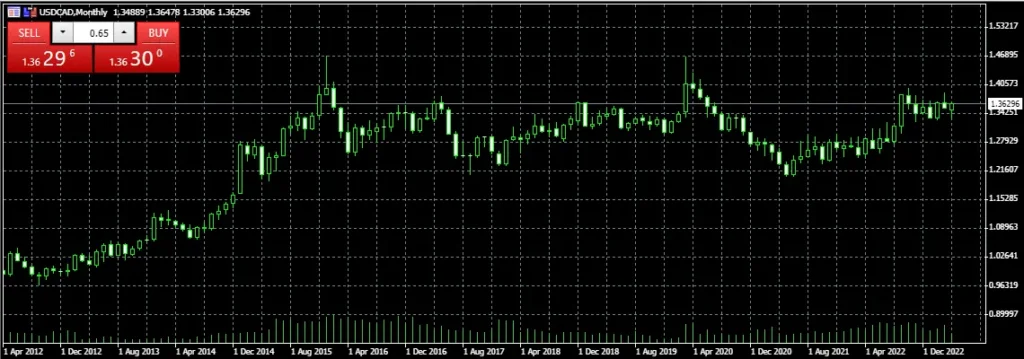The Canadian dollar, also known as the loonie, is the official currency of Canada. It is the fifth most traded currency in the world, behind the US dollar, euro, yen, and pound sterling. The USD/CAD exchange rate is the value of one US dollar in Canadian dollars.
Understanding the factors that influence the USD/CAD exchange rate is important for international trade and investments. In this article, we will provide a comprehensive guide to the loonie and the USD/CAD exchange rate.
History of the Loonie
The Canadian dollar was first introduced in 1858, replacing the Canadian pound. It was initially pegged to the US dollar at par, meaning one Canadian dollar was equal to one US dollar. In 1971, the Canadian dollar became a floating currency, meaning its value was determined by market forces of supply and demand.
The loonie gets its nickname from the image of a common loon, a type of bird found in Canada, that appears on the one-dollar coin.
Factors that Influence the Loonie
Several factors can influence the value of the loonie relative to other currencies, including:
- Commodity Prices: Canada is a major exporter of natural resources such as oil, gas, and timber. The prices of these commodities can have a significant impact on the value of the loonie. When commodity prices are high, demand for the loonie increases as foreign investors buy Canadian dollars to invest in these resources.
- Interest Rates: The Bank of Canada sets the benchmark interest rate, which can affect the value of the loonie. Higher interest rates can make the loonie more attractive to investors seeking higher yields.
- Economic Performance: Canada’s economic performance, as measured by indicators such as gross domestic product (GDP), unemployment rate, and inflation, can also affect the value of the loonie. Strong economic performance can boost demand for the loonie, while weak economic performance can lead to a decline in its value.
- Political Stability: Political stability and the perception of a stable government can also influence the value of the loonie. Investors prefer to invest in countries with stable governments and institutions, which can lead to an increase in demand for the loonie.
USD/CAD Exchange Rate
The USD/CAD exchange rate is the value of one US dollar in Canadian dollars. A higher exchange rate means that the US dollar is worth more than the Canadian dollar, while a lower exchange rate means that the Canadian dollar is worth more than the US dollar.

Historical Trends
The USD/CAD exchange rate has fluctuated over time, influenced by various factors such as economic conditions, interest rates, and geopolitical events. From 2002 to 2007, the exchange rate remained relatively stable, with the US dollar worth between 1.10 and 1.20 Canadian dollars.
In 2008, the global financial crisis caused a sharp increase in the value of the US dollar relative to the loonie, with the exchange rate reaching a high of 1.30. Since then, the exchange rate has fluctuated between 1.20 and 1.40.
Impact on International Trade and Investments
The USD/CAD exchange rate can have a significant impact on international trade and investments. A stronger US dollar relative to the Canadian dollar makes Canadian goods and services less expensive for US buyers, which can increase demand for Canadian exports.
On the other hand, a weaker Canadian dollar relative to the US dollar makes US goods and services more expensive for Canadian buyers, which can decrease demand for US exports.
Investors also pay close attention to the USD/CAD exchange rate, as it can affect the returns on their investments. For example, if an investor buys a Canadian stock with a strong outlook, but the loonie depreciates relative to the US dollar, the investor’s returns may be lower in US dollar terms.
Trade and Investment Strategies
Given the impact of the USD/CAD exchange rate on trade and investments, investors and businesses often develop strategies to manage currency risk. Some common strategies include:
- Hedging: Hedging involves taking positions that offset the risk of adverse currency movements. For example, a Canadian exporter may use a currency forward contract to lock in the USD/CAD exchange rate for a future transaction, reducing the risk of a decline in the loonie.
- Diversification: Diversification involves spreading investments across multiple currencies and asset classes to reduce overall risk. By investing in a mix of currencies and assets, investors can minimize the impact of adverse currency movements on their portfolio.
- Fundamental Analysis: Fundamental analysis involves analyzing economic and financial factors to forecast future currency movements. By staying up to date on economic indicators, such as interest rates and GDP, investors can make informed decisions about their currency exposures.
Conclusion
The Canadian dollar, or loonie, is an important currency in the global financial system. Understanding the factors that influence the value of the loonie relative to the US dollar is crucial for international trade and investments. Commodity prices, interest rates, economic performance, and political stability are some of the key factors that can affect the value of the loonie.
The USD/CAD exchange rate has fluctuated over time, with various implications for trade and investments. By developing strategies to manage currency risk, investors and businesses can mitigate the impact of adverse currency movements on their portfolios.
Your Wolf Academy offers a range of educational resources to help traders succeed, including free signals, technical analysis, and weekly webinars. Sign up today and get a recommendation for a regulated brokerage company that suits your needs.


